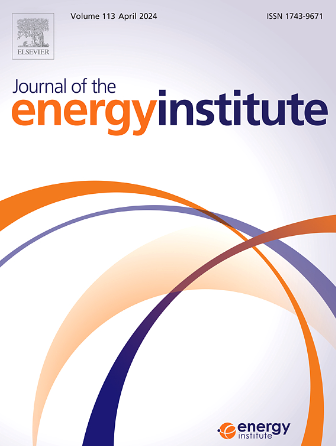A comparative investigation of biomass co-pyrolysis with polymeric wastes using electromagnetic induction heating
IF 5.6
2区 工程技术
Q2 ENERGY & FUELS
引用次数: 0
Abstract
In this study, co-pyrolysis of biomass and polymeric wastes has been conducted in an electromagnetic induction (EMI)-heated fixed-bed reactor. The biomass feedstocks were water hyacinth (WH) and vegetable waste (VW), whereas the polymeric wastes were scrap tires (ST) and low-density polyethylene (LDPE). The maximum liquid yield of 67 wt.% was obtained with a WH/LDPE blend ratio of 30:70, at 450 °C for 50 min and with particle sizes ranging from 0.5 to 2 mm. The calorific value (CV) of the obtained co-pyrolysis oil was determined to be 40.38 MJ/kg. The co-pyrolysis-oil was characterized using gas chromatography-mass spectrometry (GC-MS) and fourier-transform infrared (FTIR) spectroscopy. The findings demonstrated that the oils had superior properties, such as a higher carbon and hydrogen content, and were mainly composed of aliphatic compounds, such as olefins. The addition of polymeric wastes (LDPE and ST) increased liquid yields even though the oils from VW/ST blends had greater amounts of sulfur and nitrogen. The results showed that the wastes in the study could be transformed into liquid products that could be used as alternatives to petroleum fuels in a variety of ways. It has also been proposed that the liquid product might be a good source of a number of useful chemical compounds.
电磁感应加热生物质与高分子废弃物共热解的对比研究
本研究采用电磁感应加热固定床反应器对生物质和高分子废弃物进行共热解。生物质原料为水葫芦(WH)和植物废弃物(VW),高分子废弃物为废轮胎(ST)和低密度聚乙烯(LDPE)。当WH/LDPE共混比为30:70,温度为450℃,反应时间为50 min,粒径为0.5 ~ 2mm时,最大产液率为67 wt.%。所得共热解油的热值(CV)为40.38 MJ/kg。采用气相色谱-质谱联用(GC-MS)和傅里叶变换红外光谱(FTIR)对热解油进行了表征。研究结果表明,这些油具有优异的性能,例如碳和氢含量较高,并且主要由脂肪族化合物(如烯烃)组成。尽管VW/ST混合物中的油含有更多的硫和氮,但聚合物废料(LDPE和ST)的加入增加了液体产量。结果表明,研究中的废物可以转化为液体产品,可以以多种方式用作石油燃料的替代品。也有人提出,液体产品可能是许多有用化合物的良好来源。
本文章由计算机程序翻译,如有差异,请以英文原文为准。
求助全文
约1分钟内获得全文
求助全文
来源期刊

Journal of The Energy Institute
工程技术-能源与燃料
CiteScore
10.60
自引率
5.30%
发文量
166
审稿时长
16 days
期刊介绍:
The Journal of the Energy Institute provides peer reviewed coverage of original high quality research on energy, engineering and technology.The coverage is broad and the main areas of interest include:
Combustion engineering and associated technologies; process heating; power generation; engines and propulsion; emissions and environmental pollution control; clean coal technologies; carbon abatement technologies
Emissions and environmental pollution control; safety and hazards;
Clean coal technologies; carbon abatement technologies, including carbon capture and storage, CCS;
Petroleum engineering and fuel quality, including storage and transport
Alternative energy sources; biomass utilisation and biomass conversion technologies; energy from waste, incineration and recycling
Energy conversion, energy recovery and energy efficiency; space heating, fuel cells, heat pumps and cooling systems
Energy storage
The journal''s coverage reflects changes in energy technology that result from the transition to more efficient energy production and end use together with reduced carbon emission.
 求助内容:
求助内容: 应助结果提醒方式:
应助结果提醒方式:


